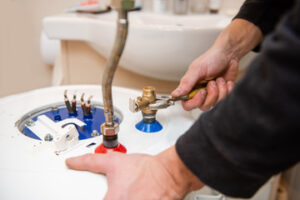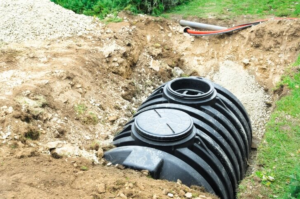Drain Cleaning Aurora, CO is vital in keeping a home’s plumbing system functional and promoting a healthy living environment. It involves clearing clogged pipes to prevent waste from backing into the plumbing system.
Several drain cleaning methods are available. One is to use a combination of baking soda and vinegar. This is effective for mild clogs and has a pleasant citrus smell.

When a plunger, plumbing snake, or chemical drain cleaners fail to work, it may be time for more drastic action. The best solution is hydrojetting, a method that uses pressurized water to wash away clogs and remove debris from pipes. It is also effective in eliminating overgrown tree roots that infiltrate sewer lines. This is a highly efficient process that requires no excavation or digging to complete.
Professional plumbers use specialized jetting equipment to blast away clogs and wash away collected debris in your home or business’s drains and sewer line. This technology shoots water at high-pressure levels of up to 35,000 psi, which is enough to cut through most obstructions and break apart stubborn blockages. It can also cut through sludge, grease, soap scum, minerals, and food residues. It is more effective at removing debris than snaking and can be used on a wider range of materials.
The plumber first inserts a durable hose downstream into the plumbing line and attaches it to a water tank that’s pressurized to the right level. Then, the plumber turns on the water and sends it through the hose. The pressure is strong enough to wash away sludge, dissolve clogs, and break up overgrown tree roots. The resulting debris gets flushed down the drains and into the sewer line, where gravity takes over.
In addition to addressing clogs, the hydrojetting process can also be used for general maintenance and to scour the inside of pipes. It’s a quick and cost-effective way to get your home or business plumbing back into tip-top shape.
Before plumbers use hydrojetting, they will conduct a video inspection of your plumbing system to determine whether the pipes can withstand the intense water pressure. Older or damaged pipes may not be able to hold up to the pressure, and they can crack or break under the force of the water. If this is the case, the plumber will use an auger instead of hydrojetting. However, the abrasive nature of this cleaning technique can still be very effective in breaking down and washing away some types of blockages.
Drain snaking
Drain snaking involves inserting a long metal rod with a hook-shaped end into a blocked drain. A manual or motorized auger is used to rotate the rod and catch, break, or disintegrate the clog. The auger head also has a latching function for hard-to-reach objects, like clumps of hair or other solid debris. Once the clog is broken up or entangled, the rod is pulled out of the pipe. Depending on the type of drain snake and the size of the clog, this may take several attempts. After the clog is removed, it is recommended to flush the pipes with water to test for full functionality.
A professional plumber is best suited for drain cleaning as they have tools and knowledge of how to use them properly. Professionals also know how to identify and address underlying issues, which can prevent future clogs. In addition, they can offer tips for avoiding future blockages, such as installing a grease trap or throwing away large food scraps rather than putting them down the drain.
In the event of a serious clog, it is important to call a plumber as soon as possible to avoid potential damage. Some clogs are too severe for DIY solutions, and store-bought chemical cleaners may not fully dissolve or break up a large blockage. Additionally, some clogs occur deep in the drain pipes or toilet, which requires professional equipment to access and clear.
If you’re facing a minor clog, you can try to clear it with your own hand snake or a simple tool such as a bent wire coat hanger. To begin, disassemble a coat hanger and create a long, straight strip with the hook shape at one end. Push the hooked end into the drain opening and crank or turn the handle to feed it slowly into the pipe.
Once you reach the clog, rotate and advance the snake gradually until you feel it hook or disintegrate it. Be careful not to apply excessive force, as doing so can damage the snake or pipe. As you reach the clog, it’s likely that it will become stuck on or entangled in the snake’s coil.
Chemical drain cleaners
Chemical drain cleaners are liquid, gel or powder products that claim to dissolve blockages in your plumbing. They are readily available in hardware, home improvement and big box stores and are marketed as easy-to-use and effective solutions for stubborn clogs. These cleaners are based on chemical reactions that produce heat or gas and disintegrate the organic material in the clog. Despite their popularity, they should be used sparingly and as a last resort. The chemicals can damage your pipes and are harmful to the environment. They also don’t address the root cause of the clog, so they are only a temporary solution.
The primary ingredient in most chemical drain cleaners is acid. It’s the same substance that makes lye work to create soap, and it’s what burns away fats and dissolves grease clogs. These cleaners are effective because they donate or absorb electrons to and from the clog material, which breaks down its molecules and turns it into a watery solution that can be easily flushed from your pipes.
Most chemical drain cleaners are also toxic to people and pets. They release harsh fumes that irritate the nose, eyes and skin. If your space doesn’t have enough ventilation, these cleaners can also affect your indoor air quality (IAQ). Some of them are also dangerous to touch and may cause chemical burns if they come into contact with your skin or if you inhale them.
Another concern with chemical drain cleaners is that they often don’t reach clogs far from the pipe opening. This is because most of them are based on chemical reactions that only break down materials within a certain range of pH levels.
For example, the acid in sulfuric and hydrochloric chemical drain cleaners can melt PVC pipes and worsen corrosion in iron or copper pipes. They are also dangerous to septic systems because they kill the bacteria that process waste and contaminate the soil around the plumbing system. For these reasons, you should avoid using chemical drain cleaners unless they are specifically recommended by a professional plumber. Instead, call a professional who can use mechanical tools to remove the clog and inspect your pipes for the root cause of the problem.
Plumber’s snake
The plumber’s snake (also called a drain auger) is one of the most important tools in the plumbing professional’s arsenal. It consists of small metal blades attached to a long cable, which can be inserted into the pipes to break up and cut through clogs. The snake can also be used to clear out stubborn obstructions like hair and toilet paper. It is a quick solution for clogged drains, but it is not a permanent fix. Leftover debris can build up over time and cause future clogs.
You should never use too much force when using a plumber’s snake, as this can damage the pipe or sewer lines. Also, be careful not to poke into the wall of your house, as this can lead to a major plumbing problem. The best way to avoid this is by preventing blockages in the first place.
Before using the snake, prepare the area by removing any sludge or food residue from the sink or drain. It is also a good idea to remove the p-trap (the curved piping under the sink) so that you can reach the actual pipe directly. This will make snaking easier.
Once the snake is in the clogged pipe, slowly rotate and maneuver it against the clog to break up or entangle it. If the clog is particularly stubborn, it may be necessary to use more force. Always be careful when handling the snake, as it can be slippery and dangerous.
After you have successfully removed the clog, be sure to clean the snake with hot water and soap. This will help to prevent bacteria-laden waste from re-forming on the spring or along the cable. It is also a good idea to replace the spring and the end of the cable, which can easily become brittle over time.
To keep your drains clear, put strainers or screens over all the drains in your home. This will catch larger food scraps and other debris and prevent them from washing down the drains. In addition, always dispose of grease and oils in a separate container instead of pouring them down the drains. You should also install a grease trap to prevent fats from building up in your pipes.

